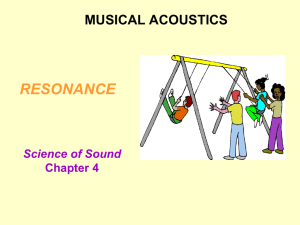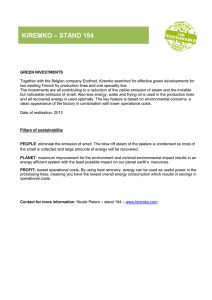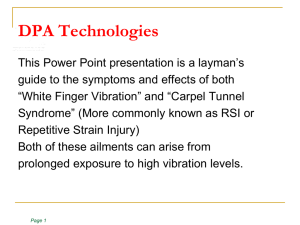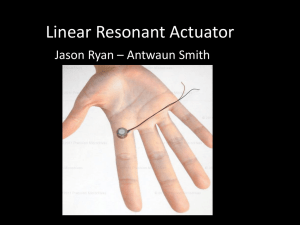Use of Acoustic Emission in Gearbox Condition
advertisement
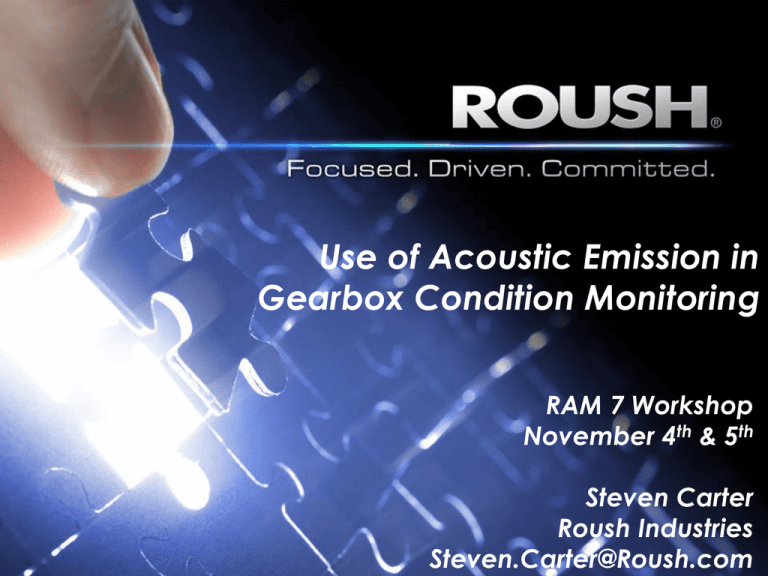
Use of Acoustic Emission in Gearbox Condition Monitoring RAM 7 Workshop November 4th & 5th Steven Carter Roush Industries Steven.Carter@Roush.com Condition Based Maintenance • Condition based maintenance(CBM) is the practice of providing maintenance when needed. – Effective gearbox CBM is reliant on condition indicators(CIs). – Current primary gear CIs are vibration, temperature, and oil debris based. – Developing research is showing the benefits of acoustic emission(AE) based CIs. 2 Outline • Vibration based condition monitoring theory. • Acoustic emission condition monitoring theory. • Current research on AEs applicability to gearbox condition monitoring. • Theoretical comparison between AE and vibration. • Case study of data collected by Roush. 3 Vibration Based Gearbox Condition Monitoring • Vibration based indicators are typically used to measure data distribution and energy off of major meshing harmonics. Typical Condition Indicator Calculation Process Collection of vibration data Development of time synchronous averaged signal Development of residual/difference signal Typical CI “Base” Metrics – RMS – Peak Level – Normalized kurtosis 4 – Crest factor – Peak-Peak level – Sideband levels Condition indicator calculation Vibration Based Gearbox Condition Monitoring – Cont. • Normalized Kurtosis – Kurtosis is a measure of a data sets peakedness and is normalized to reduce sensitivity to the data sets standard deviation. This measure is the basis for FM4 and NA41,2. dn d N n 1 1 _ N 4 2 1 N _ d nd N n 1 • Crest Factor – The ratio of a data sets peak value to its RMS level. d peak d rms 5 2 Vibration Based Gearbox Condition Monitoring – Cont. • FM0 – The ratio of a data sets peak-to-peak level to the sum of rms levels of the main gear mesh harmonics1. d peak peak n i f • 6 i primary d f i mesh harmonics Sideband Levels – Several condition indicators exist which measure the amplitude of orders (typically first order sidebands) centered about the primary gear mesh frequency. Acoustic Emission Theory - Background • Acoustic emission is defined as transient elastic waves caused by the release of localized stress energy. • Originally developed in the 1960s for static testing. • Very popular in non-destructive testing: – Pipeline leak detection. – Structural health monitoring. • Sensitive to crack formation in both metals and composites. • Generally measured in the 100kHz to 1MHz frequency range. • Relatively new to gearbox condition monitoring. 7 Acoustic Emission Theory - Introduction • Acoustic emission can be thought of as an analog to structural vibration. 8 Phenomena Source Path Receiver Acoustic Emission Mechanical disturbance causing the release of local stress energy. Wave propagation through structure. Mechanical motion at sensor location. Vibration Mechanical phenomena causing input force. Vibration propagation due to system dynamic response. Mechanical vibration at sensor location. Acoustic Emission Theory – Source • AE events are caused are caused by the release of localized stress energy. • Micro-cracks caused by fatigue, thermal loading, etc. • Crack initiation, crack propagation, plastic deformation, impact, and friction. Shifts in the materials micro-structure are common AE sources 9 Acoustic Emission Theory – Path • AE waves are transmitted through the structure via Lamb and Rayleigh waves. • Reduced sensitivity to mechanical resonance and outside noise due to frequency band and mode type. Lamb Waves Extensional Mode Rayleigh Wave Flexural Mode Rayleigh wave motion process. Graphic. Accessed October 19, 2014. http://folk.uio.no/valeriem/spice/Frame/surfacew/index.html Plate Motion for the Two Zero-order Lamb Wave Modes. Graphic, Wikipedia. Accessed October 19, 2014. http://en.wikipedia.org/wiki/Lamb_waves 10 Acoustic Emission Theory – Receiver • AE energy is measured through piezo-electric transducers. • Transducers can have either a wideband or narrowband frequency response. • Mounted in a similar manner to accelerometers. – Silicone grease is typically used as a coupling agent. • Sensors come in a variety of sizes and weights. Kistler AE sensor used for testing at Roush 11 Acoustic Emission Theory – Measurement • AE is measured via several methods. – Hit count – RMS level – Raw time data (typically recorded based off pre-set triggers) • Sample rates vary up to 40MHz. Typical AE RMS level vs. time Measurement • Measurement locations are defined through sensitivity studies such as the pencil lead break test7 12 AE Based Gearbox Condition Monitoring – Previous Research • AE has been shown to identify faults faster then vibration3, 5. – In one case it was noted that AE detected pitting at 8% pitted area compared to vibration detecting pitting at 30% pitted area6. • It has been shown that AE amplitude and energy increases with pitting5, 6. • Torque appears to have a minimal effect on AE rms levels; however, gearbox speed does appear to have an effect5,6. 13 AE Based Gearbox Condition Monitoring – Previous Research • Heterodyne-based frequency reduction technique has been successfully applied to sample AE at 100kHz3. • Toutountzakis et al4 were able to measure the gear meshing AE transient response. – Unable to measure differences in AE data from seeded pitting. • In particular, previous work by the Physical Acoustics Corporation (Mistras) has shown the success of acoustic emission when applied to a BV-107 helicopter8. 14 Acoustic Emission Vs. Vibration Vibration Measurement Source Phenomena: Measurement Source Phenomena: • • Force variation/transmission error. Impulse from the release of localized stress energy. Pros/Cons: Pros/Cons: • • • • • • Large body of research. Ease of data acquisition. Largely controlled by system dynamics. Dependent on total system vibration. Complex signal processing. • • • • • • 15 Acoustic Emission Insensitivity to system dynamics and total system vibration. Potential to detect faults sooner. Potentially high signal attenuation in system. Relatively small amount of research. Actual source mechanism is not fully understood3. Potentially difficult data acquisition. Potential simplicity of signal processing. Acoustic Emission Vs. Vibration 16 Vibration Acoustic Emission Bottom Line: Vibration has historical prominence in gearbox condition monitoring but is fraught with difficulties. Bottom Line: AE shows significant potential but much work is still required to fully understand its use in gearbox condition monitoring. Roush Test Stand Brake Gearbox Under Test Drive Motor 17 Roush Test Stand – Measurement Set-Up Kistler AE Sensor Laser Tachometer for Shaft Speed Sensor: Kistler Model #8152B111 Response: Wideband – 200-500kHz filtered Output: RMS – 0.12ms time constant Measurement Method: 60s RMS vs. time at 15-30min increments 18 Baseline Gearbox – AE Data Typical AE Data AE Data Immediately Prior to Inspection AE Out (Volts) Consistent, high amplitude hits 1.38HP, 7.2Nm Load Case (Estimated) 19 0.78HP, 4.1Nm Load Case (Estimated) ~16-20hrs of run time between these measurements. Test-stand downtime Baseline Gearbox – Gear-Set – Post Run This gear set started from a new condition and was ran intermittently for several months. Damage was found in a routine inspection after an uptick in AE activity was noticed. High wear was seen on both the ring and pinion gear faces 20 Baseline Gearbox – Gear-Set – Post Run 21 Natural Wear Gearbox – AE Data AE Out (Volts) Consistent, high amplitude hits Test-stand downtime 0.1HP, 0.9Nm Load Case (Estimated) 22 0.78HP, 4.1Nm Load Case (Estimated) Natural Wear Gearbox – Gear-set – Post Run This gear set started from a new condition and was ran for 5 days when significant wear was expected based on the AE data. Wear was seen on both the ring and pinion gear faces 23 Natural Wear Gearbox – Gear-set – Post Run 24 Roush Testing - Findings • While small compared to AE hits, the RMS level is sensitive to gearbox load. • AE does not appear to be sensitive to seeded faults. • AE does appear to be sensitive to natural wear as exhibited in the shown data. – Wear in gear sets. – Crack in bellows coupling. – Drive motor failure. 25 Questions? References 1. 2. 3. 4. 5. 6. 7. 8. 27 Zakrajsek James J. An Investigation of Gear Mesh Failure Prediction Techniques. NASA Technical Memorandum 102340. 1989. Antolick Lance J., Branning Jeremy S., Wade Daniel R., Dempsey Paula J. Evaluation of Gear Condition Indicator Performance on Rotorcraft Fleet. American Helicopter Society 66th Annual Forum Conference Proceedings. 2010. Yongzhi Qu, He David, Yoon Jae, Van Hecke Brandon, Bechhoefer Eric, Zhu Junda. Gearbox Tooth Cut Fault Diagnostics Using Acoustic Emission and Vibration Sensors – A Comparative Study. Sensors 14, no 1. 2014. Tountountzakis Tim, Keong Tan Chee, Mba David. Application of Acoustic Emission to Seeded Gear Fault Detection, NDT&E International, Volume 38, Issue 1. 2005. Tountountzakis Tim, Mba David. Observations of Acoustic Emission Activity During Gear Defect Diagnosis. NDT&E International, Volume 36, Issued 7. 2003. Mba David. Prognostic Opportunities Offered by Acoustic Emission for Monitoring Bearings and Gearboxes. Twelfth International Congress on Sound and Vibration. 2005. ASTM Standard E976, 2010. Standard Guide for Determining the Reproducibility of Acoustic Emission Sensor Response. ASTM International. West Conshohocken, PA. 2010. DOI: 10.1520/E0976-10. www.astm.org. Application of Acoustic Emission to Health Monitoring of Helicopter Mechanical System. Physical Acoustics Corporation. www.pacndt.com.


